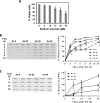Inorganic arsenic inhibits the nucleotide excision repair pathway and reduces the expression of XPC
- PMID: 28237621
- PMCID: PMC5535078
- DOI: 10.1016/j.dnarep.2017.02.009
Inorganic arsenic inhibits the nucleotide excision repair pathway and reduces the expression of XPC
Abstract
Chronic exposure to arsenic, most often through contaminated drinking water, has been linked to several types of cancer in humans, including skin and lung cancer. However, the mechanisms underlying its role in causing cancer are not well understood. There is evidence that exposure to arsenic can enhance the carcinogenicity of UV light in inducing skin cancers and may enhance the carcinogenicity of tobacco smoke in inducing lung cancers. The nucleotide excision repair (NER) pathway removes different types of DNA damage including those produced by UV light and components of tobacco smoke. The aim of the present study was to investigate the effect of sodium arsenite on the NER pathway in human lung fibroblasts (IMR-90 cells) and primary mouse keratinocytes. To measure NER, we employed a slot-blot assay to quantify the introduction and removal of UV light-induced 6-4 photoproducts (6-4 PP) and cyclobutane pyrimidine dimers (CPDs). We find a concentration-dependent inhibition of the removal of 6-4 PPs and CPDs in both cell types treated with arsenite. Treatment of both cell types with arsenite resulted in a significant reduction in the abundance of XPC, a protein that is critical for DNA damage recognition in NER. The abundance of RNA expressed from several key NER genes was also significantly reduced by treatment of IMR-90 cells with arsenite. Finally, treatment of IMR-90 cells with MG-132 abrogated the reduction in XPC protein, suggesting an involvement of the proteasome in the reduction of XPC protein produced by treatment of cells with arsenic. The inhibition of NER by arsenic may reflect one mechanism underlying the role of arsenic exposure in enhancing cigarette smoke-induced lung carcinogenesis and UV light-induced skin cancer, and it may provide some insights into the emergence of arsenic trioxide as a chemotherapeutic agent.
Keywords: Arsenic; Lung cancer; Nucleotide excision repair; Skin cancer; UV light; XPC.
Copyright © 2017 Elsevier B.V. All rights reserved.
Conflict of interest statement
The authors declare that there are no conflicts of interest
Figures
Similar articles
-
Exposure of Human Lung Cells to Tobacco Smoke Condensate Inhibits the Nucleotide Excision Repair Pathway.PLoS One. 2016 Jul 8;11(7):e0158858. doi: 10.1371/journal.pone.0158858. eCollection 2016. PLoS One. 2016. PMID: 27391141 Free PMC article.
-
Phloroglucinol enhances the repair of UVB radiation-induced DNA damage via promotion of the nucleotide excision repair system in vitro and in vivo.DNA Repair (Amst). 2015 Apr;28:131-8. doi: 10.1016/j.dnarep.2015.02.019. Epub 2015 Feb 28. DNA Repair (Amst). 2015. PMID: 25766644
-
Nicotinamide enhances repair of arsenic and ultraviolet radiation-induced DNA damage in HaCaT keratinocytes and ex vivo human skin.PLoS One. 2015 Feb 6;10(2):e0117491. doi: 10.1371/journal.pone.0117491. eCollection 2015. PLoS One. 2015. PMID: 25658450 Free PMC article.
-
Cell type and DNA damage specific response of human skin cells to environmental agents.Mutat Res. 2007 Jan 3;614(1-2):37-47. doi: 10.1016/j.mrfmmm.2006.06.009. Epub 2006 Aug 1. Mutat Res. 2007. PMID: 16879839 Review.
-
Nucleotide Excision Repair and Vitamin D--Relevance for Skin Cancer Therapy.Int J Mol Sci. 2016 Apr 6;17(4):372. doi: 10.3390/ijms17040372. Int J Mol Sci. 2016. PMID: 27058533 Free PMC article. Review.
Cited by
-
Arsenic co-carcinogenesis: Inhibition of DNA repair and interaction with zinc finger proteins.Semin Cancer Biol. 2021 Nov;76:86-98. doi: 10.1016/j.semcancer.2021.05.009. Epub 2021 May 10. Semin Cancer Biol. 2021. PMID: 33984503 Free PMC article. Review.
-
Arsenic Toxicity: Molecular Targets and Therapeutic Agents.Biomolecules. 2020 Feb 4;10(2):235. doi: 10.3390/biom10020235. Biomolecules. 2020. PMID: 32033229 Free PMC article. Review.
-
Inhibitors of Nucleotide Excision Repair Decrease UVB-Induced Mutagenesis-An In Vitro Study.Int J Mol Sci. 2021 Feb 6;22(4):1638. doi: 10.3390/ijms22041638. Int J Mol Sci. 2021. PMID: 33562002 Free PMC article.
-
Update of the risk assessment of inorganic arsenic in food.EFSA J. 2024 Jan 18;22(1):e8488. doi: 10.2903/j.efsa.2024.8488. eCollection 2024 Jan. EFSA J. 2024. PMID: 38239496 Free PMC article.
-
Rs3212986 polymorphism, a possible biomarker to predict smoking-related lung cancer, alters DNA repair capacity via regulating ERCC1 expression.Cancer Med. 2018 Dec;7(12):6317-6330. doi: 10.1002/cam4.1842. Epub 2018 Nov 19. Cancer Med. 2018. PMID: 30453383 Free PMC article.
References
-
- Bolt HM. Arsenic: an ancient toxicant of continuous public health impact, from Iceman Otzi until now. Arch Toxicol. 2012;86(6):825–30. - PubMed
-
- Nordstrom DK. Public health. Worldwide occurrences of arsenic in ground water. Science. 2002;296(5576):2143–5. - PubMed
-
- Yager JW, Greene T, Schoof RA. Arsenic relative bioavailability from diet and airborne exposures: Implications for risk assessment. Sci Total Environ. 2015;536:368–81. - PubMed
Publication types
MeSH terms
Substances
Grants and funding
LinkOut - more resources
Full Text Sources
Other Literature Sources
Miscellaneous







